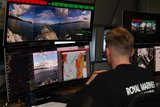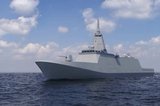SM-3 Block IIA in new intercept test
The US Navy and the Missile Defense Agency (MDA) have successfully completed the intercept flight test of Raytheon's Standard Missile-3 (SM-3) Block IIA from USS John Paul Jones against a land-launched target resembling an advanced ballistic missile threat, the company announced on 4 February.
The mission was designed to evaluate key missile system performance, including the kinetic warhead, divert and attitude control system functionality, nosecone performance, steering control section function, booster performance and separation, second and third stage rocket motor performance and separation.
The interceptor's kinetic warhead has been designed to address advanced and emerging threats, with improvements to the search, discrimination, acquisition and tracking functions. The kinetic warhead allows SM-3 Block IIA to engage more sophisticated threats and protect larger regions from short- to intermediate-range ballistic missile threats, providing greater operational flexibility.
Taylor W Lawrence, president at Raytheon Missile Systems, said: 'The SM-3 Block IIA programme continues to reflect MDA's commitment to maturing this regional ballistic missile defence capability for the defence of our nation, its deployed forces and our allies abroad.'
Future flight tests will continue to evaluate system performance, en-route to a 2018 deployment in support of the European Phased Adaptive Approach Phase 3.
The SM-3 Block IIA has previously undergone testdemonstrations without target intercepts, in order to evaluate the missile and prepare for the first intercept test.
More from Naval Warfare
-
![NATO tests use of “undetectable, jam-proof” laser communication in maritime scenarios]()
NATO tests use of “undetectable, jam-proof” laser communication in maritime scenarios
As part of its effort to better prepare its capabilities for operations in contested and congested scenarios, NATO evaluated a Lithuanian ship-to-ship terminal designed to not be susceptible to enemy interference.
-
![US Navy advances with the Harpoon Service Life Extension Programme]()
US Navy advances with the Harpoon Service Life Extension Programme
The US Navy plans to improve Harpoon’s anti-ship and land attack capabilities by equipping the missiles with sensors and technologies required for succeeding in future battlespace.
-
![Mitsubishi eyes future with Australia’s Mogami selection]()
Mitsubishi eyes future with Australia’s Mogami selection
With Australia’s selection of the Mogami-class for Project Sea 3000, Mitsubishi is investigating local production in the next decade as potential export opportunities emerge.
-
![Thales’ new Sonar 76Nano could equip UK Royal Navy on anti-submarine warfare missions]()
Thales’ new Sonar 76Nano could equip UK Royal Navy on anti-submarine warfare missions
The new sonar is designed to equip uncrewed underwater vessels, with the potential to be used by the Royal Navy for its Atlantic Bastion and Atlantic Net missions.
-
![Hanwha wins Australian government approval to increase its stake in Austal]()
Hanwha wins Australian government approval to increase its stake in Austal
The contract would mean the two shipbuilders can collaborate strategically and enhance shipbuilding capabilities in Western Australia.























